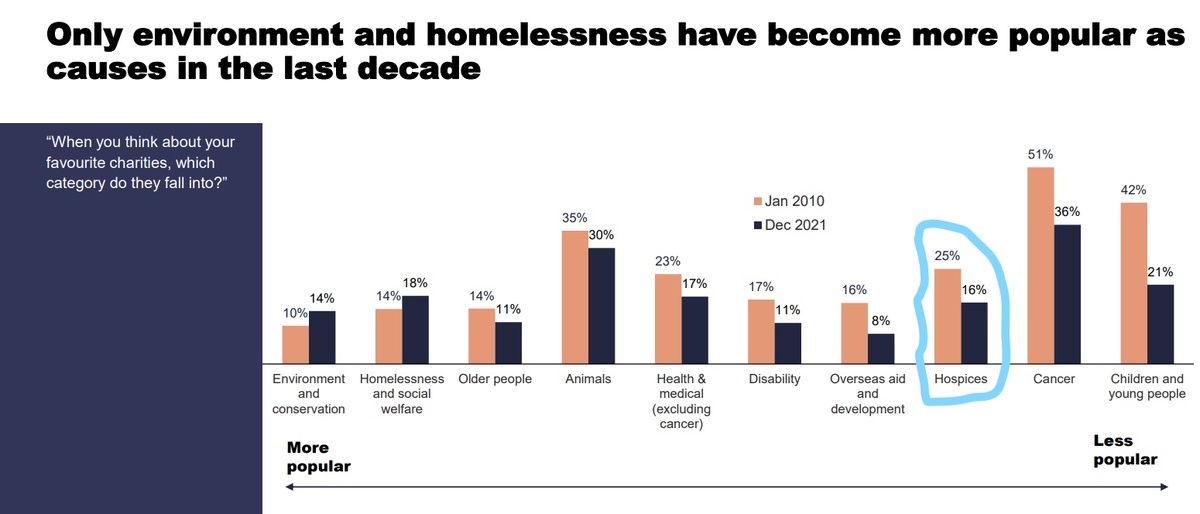
Sometimes you see something that makes you really question your assumptions.
This happened to me recently watching a presentation by NfP Research. Previous slides had already been rather downbeat. But then they showed this one, looking at how the popularity of various causes, including hospices, has changed over the last decade.
So, in 2010, hospices were the 4th most popular cause, selected by 25% of people. In December 2021 they were 6th, chosen by 16%. Sure, other causes saw equal, if not bigger, declines. But, haven’t we always thought we were a bit ‘different’ to others; a bit ‘special’ and that the public will always love us? No doubt they do. But maybe not as much as we thought.
There is certainly evidence that hospices have had challenges in their revenue raising efforts in recent years. The latest Hospice Accounts report shows how the overall ROI for all income generation dropped in the years before the pandemic, from £2.61 in 2012 to £2.22 in 2020.
Clearly, Covid had a huge impact on the sector and hospices played a major role in supporting the NHS through the worst times of the pandemic. Yet, from a purely financial perspective in 2020/21, many (certainly English) hospices had one of their best ever years. This was of course largely down to Governmental support.
For a group of 12 hospices I worked with, the special Covid funding given to hospices contributed to a collective surplus of £14.6 million. Without it – even including furlough payments and other Covid monies available to all organisations - they would have lost £14.1 million.
With a very gloomy economic outlook, the impact of Ukraine and growing demand of EOL care, signs are that the funding challenges that existed before the pandemic will be even more acute in the years ahead.
My last blog talked about the importance of being open with users about how services are funded. But we also need to overcome our own inhibitions in how we ask for support from the public.
By this I mean, hospices have always been more comfortable with transactional income generation activities – shops, lotteries, events – where people get something tangible for their support. These obviously have their place as important ways to raise money. But they are more expensive and less lucrative than more transformational methods – regular giving, legacies, major donors.
Here the ‘return’ is more emotional, but also therefore more meaningful. Yes, legacies are already a large source of income. But all the evidence is that the sector is losing market share, partly because hospices spend less than other charities in promoting legacies. Contact me for the report I produced on hospice legacies with Legacy Foresight if you want to learn more.
I tested this theory out with a group of Trustees at a Hospice UK event. 62% of participants agreed that, yes, they were more comfortable with the transactional activities.
From a financial perspective, hospices have come out of the pandemic in a better place than al other parts of the voluntary sector. The opportunity now exists to make serious investment in transformational income generation activities a key part of their ‘new normal’.
This, in turn, will make them best placed for the challenges that lie ahead in supporting patients and their families.
PS. Please contact me to get a full copy of the Nfp Research report


